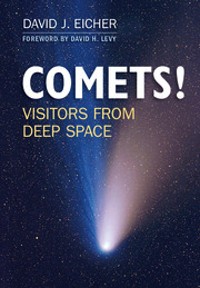Review: COMETS!by Jeff Foust
|
| He warns that “predicting comet magnitudes makes for a dangerous game,” as Comet Kohoutek demonstrated. |
As the capitalization and punctuation in the title suggest, Eicher is enthusiastic about comets, in particular an informal class he calls “Great Comets.” He offers no specific definition of such objects, beyond “You know a Great Comet when you see one.” In other words, it’s a brilliant object, easily visible to the naked eye that “causes the most casual observer… to look up at the globing specter and say, ‘WOW!’—or maybe even something a little stronger.” He estimates there have been 70 Great Comets over the last two millennia, going back to “Caesar’s Comet” seen by the Romans after the assassination of Julius Caesar.
Much of the book is a historical overview of comets, as Eicher steps the reader through a chronological overview of the study of comets in general, followed by one specifically focused on his class of Great Comets. Even his discussion of the science of comets often steps through the discoveries about their nature chronologically, turning this more into an astronomical history book than anything else. The final chapters of the book, though, offer some more practical advice for amateur astronomers interested in observing comets and even joining the hunt to discover new ones.
Eicher doesn’t devote a lot of discussion in the book about the next potential Great Comet, ISON, but he does note the potential of it to be a comet whose brightness is “unprecedented in our lifetimes.” Yet, he warns, “predicting comet magnitudes makes for a dangerous game,” noting the cautionary tale of Comet Kohoutek 40 years ago. The comet was predicted by many—including an astronomer with a growing public profile named Carl Sagan—to be bright, but instead it fizzled. “ISON will be a great sight: no doubt,” Eicher concludes. “Only by early 2014 will we all know whether it was really the comet of our lifetimes, the century, several centuries, or just another pretty good comet.” If Comet ISON turns out only to be a “pretty good” comet, rather than a Great Comet, COMETS! offers a reminder of what we’re missing even as we enjoy the spectacle.
